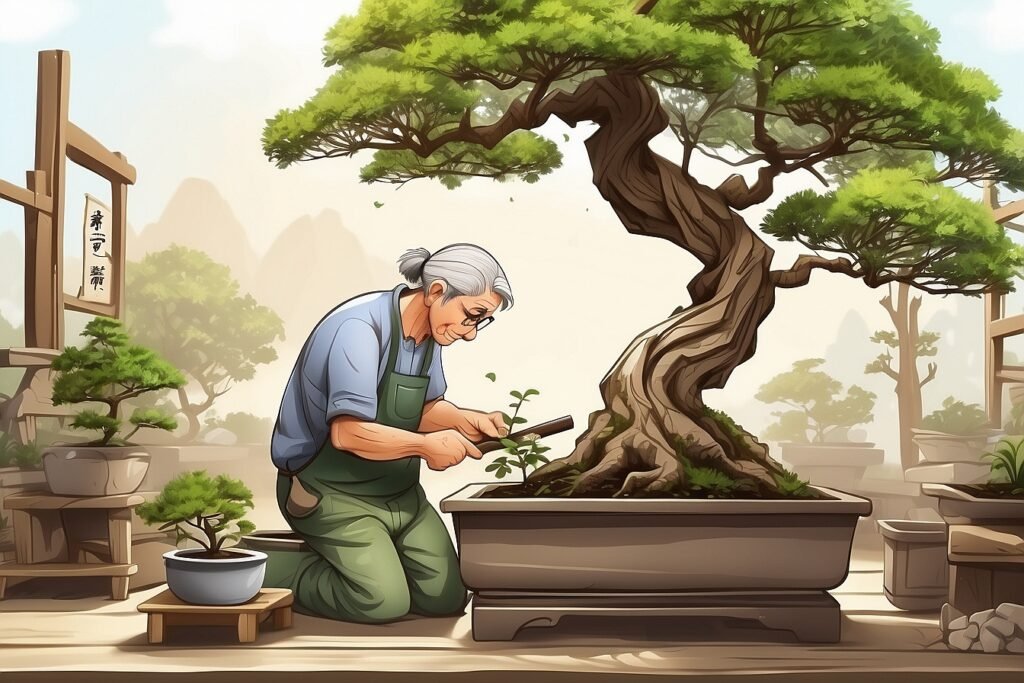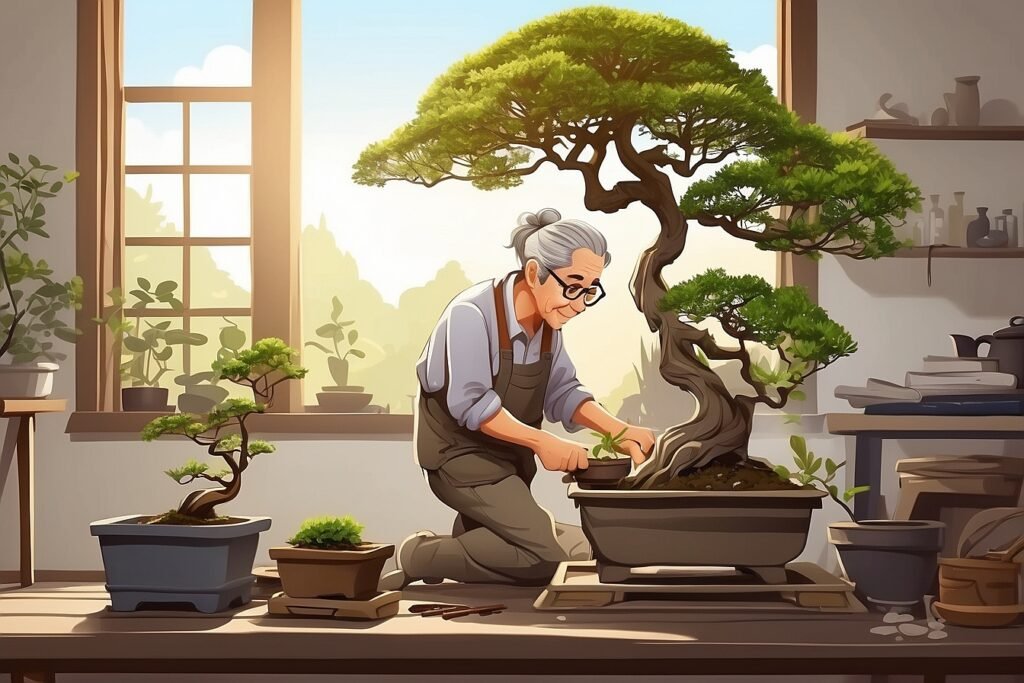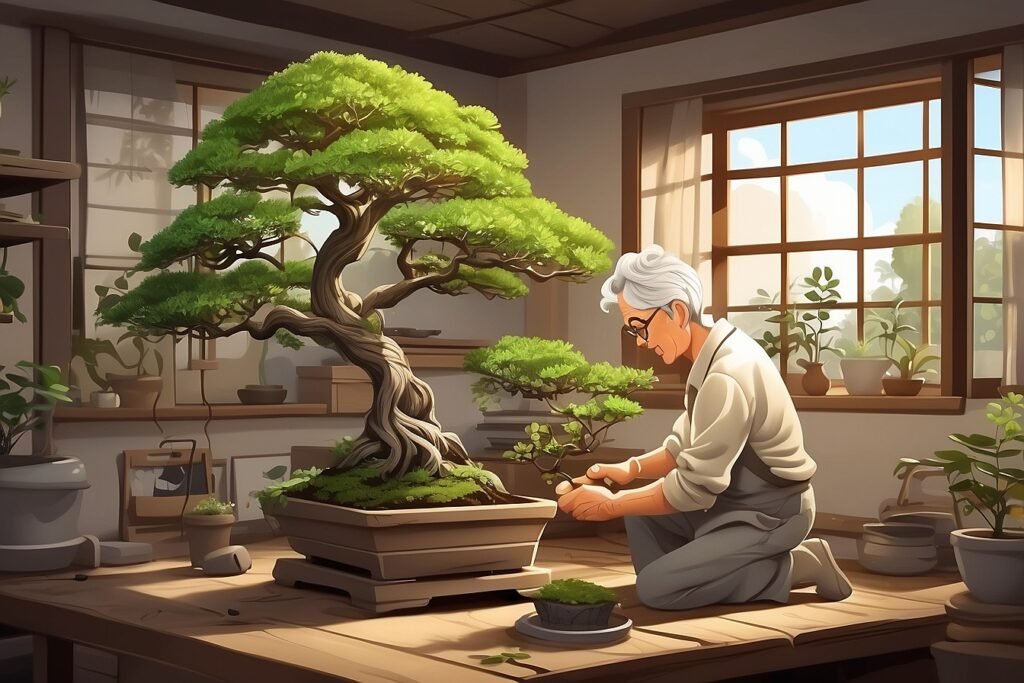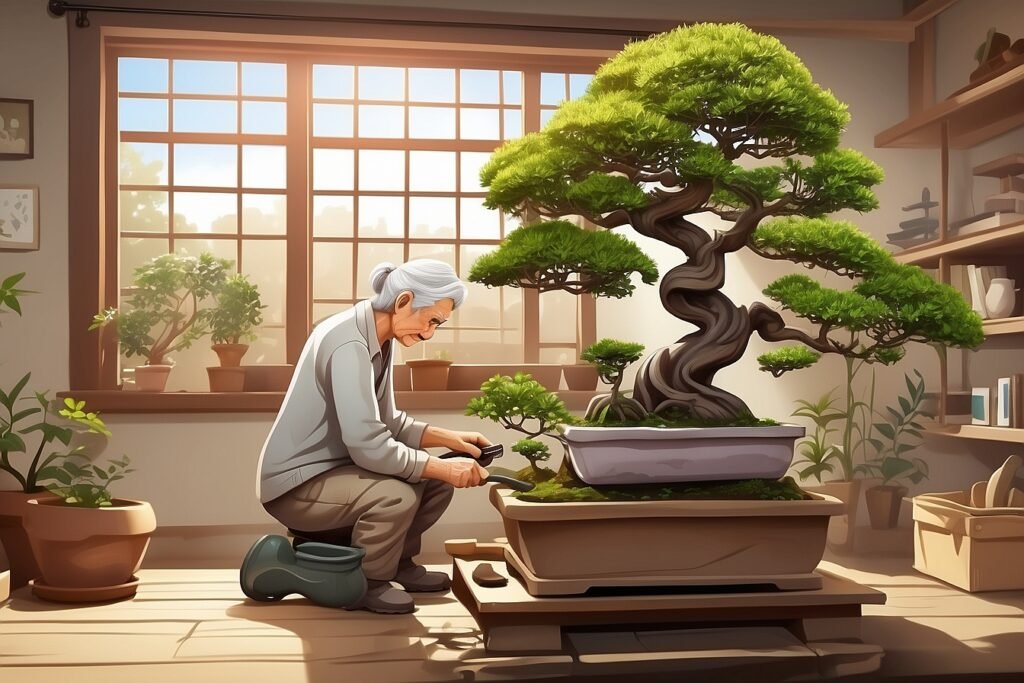If you want to add charm to your bonsai collection, the Birch Bonsai (Betula) is a fantastic choice. Not only is this tree a quick grower, but its small leaves and unique bark give it a different and beautiful look. It’s a sturdy tree that can adjust to other styling techniques. So, if you’re considering adding a Birch Bonsai to your collection, here are some key points to remember.

- Attractive Features: Birch bonsai trees add beauty to any garden with their slim profile, engaging bark, and delicate foliage.
- Hardiness: These trees can handle frost, which is excellent for different climates.
- Versatility in Styling: Birch bonsai can be grown in styles such as informal upright, weeping, clump, or multi-trunk.
| Characteristics | Details |
|---|---|
| Growth Speed | Fast |
| Leaf Size | Small |
| Bark Appearance | Mature and Attractive |
| Frost Tolerance | High |
| Styles | Informal Upright, Weeping, Clump/Multi-Trunk |
If you’re looking for a great bonsai tree that is perfect for beginners and experts, consider the Birch Bonsai (Betula). A charming little tree can add a unique character to your garden. Just be sure to take good care of it and give it the attention it needs, and you’ll be enjoying its beauty in no time!
Special Care of Your Birch Bonsai and Upkeep Essentials
If you’re caring for a Birch Bonsai (Betula), it’s essential to understand its specific needs. These trees are stunning but require a bit extra attention to thrive. Don’t worry, though; I’m here to help! Here are some essential care tips that will keep your Birch Bonsai looking its very best:
- Sunlight: Place your Birch Bonsai tree in a location with plenty of sun to ensure adequate daylight.
- Watering: Birch Bonsais require frequent watering, and the soil should always dry out.
- Fertilizing: For these trees to grow fast, they need regular feeding. During the growing season, use a balanced bonsai fertilizer.
- Pruning: To maintain the shape and size of your Birch Bonsai, it’s crucial to prune back new growth regularly during the growing season.
- Repotting: Birch Bonsais need to be repotted every two years for their rapid growth to refresh the soil and provide more space for root growth.
- Protection: During extreme weather conditions, move your Birch Bonsai indoors to protect them from severe cold spells, although they are frost tolerant.
| Care Aspect | Birch Bonsai Requirement |
|---|---|
| Sunlight | Plenty |
| Watering | Regular |
| Fertilizing | Balanced bonsai fertilizer |
| Pruning | Regular during growing season |
| Repotting | Every 2 years |
| Protection | From extreme weather |
Species and Varieties for Birch Bonsai
There are several Birch species you can choose from for your bonsai.

- Cherry Birch: Cherry Birch is a favored bonsai tree due to its appealing bark and foliage.
- Bog Birch: This species is ideal for regions with high rainfall due to its ability to thrive in moist soil.
- Himalayan Birch: This species has a beautiful white bark that can add a unique aesthetic to your collection.
- Paper Bark Birch: This type has a unique paper-like bark that peels off in strips, giving your bonsai an exciting texture.
- Japanese White Birch: This variety’s bright white bark and delicate leaves offer a stunning contrast.
- Dwarf Birch: This compact variety offers the same charm as larger ones, perfect for smaller spaces.
- River Birch: This species is highly resistant to diseases and pests, making it a solid and durable option.
- Weeping Birch: This variety can bring drama to your bonsai collection with its drooping branches.
- Silver Birch: The Birch variety is known for its beautiful silvery-white bark and graceful form, making it a visually appealing option.
White Bark and Delicate Leaves of Birch Bonsai
Birch Bonsai trees, native to Europe and parts of Asia, are renowned for their unique characteristics that make them a popular choice among bonsai enthusiasts. Here’s what sets them apart:

| Characteristic | Description |
|---|---|
| Bark | White |
| Leaves | Delicate, Triangular, Double-Toothed, Serrated Margins |
| Trunk | Slender |
| Height | Can reach up to 25 meters |
| Hardiness | High |
| Frost Tolerance | High |
| Styling Versatility | Informal Upright, Weeping, Clump or Multi-Trunk |
If you’re planning to get these lovely trees, it’s worth noting that they do require a bit of special care and attention. But don’t worry, it’s not too complicated! Regular pruning can help improve their growth, and repotting every two to four years with a little root pruning is important too. Make sure to give them plenty of water, especially during the summer, but don’t overdo it. And don’t forget to fertilize them with organic fertilizers – either in solid or liquid form – to keep them healthy and happy!
Techniques for Informal Upright, Weeping, and Clump/Multi-Trunk Styles
Whether you’re a beginner or an experienced bonsai enthusiast, you can train your Birch Bonsai in various forms that suit your aesthetic preferences. Here are three standard training techniques that you might find helpful:

- Informal Upright Style: This is a popular style for Birch Bonsai trees. It involves creating a tree with a straight trunk that slightly curves in different directions, giving it a natural and casual appearance. To achieve this, you can wire the trunk and gently bend it to create subtle curves.
- Weeping Style: The Weeping Style mimics the graceful droop of mature birch trees in nature. You can wire the branches and gently bend them downwards to achieve this style. Monitoring the wire regularly is essential to prevent it from cutting into the bark as the tree grows.
- Clump/Multi-Trunk Style: This style involves growing multiple trunks from a single root system, creating a mini-forest effect. You can achieve this by planting several Birch saplings together and allowing them to grow collectively.
Shaping Your Birch Bonsai: Importance of Pruning and Wiring
Shaping your Birch Bonsai tree is not just about aesthetics; it’s an essential part of maintaining the health of your tree. Two crucial techniques to achieve this are pruning and wiring.

- Pruning: This technique involves selectively removing parts of the plant, such as branches, buds, or roots. Regular pruning helps maintain the desired shape of your bonsai, promotes more compact growth, and enhances the tree’s overall health.
- Structural Pruning: This is usually done during late winter when the tree is dormant. It involves removing undesirable branches to improve the tree’s structure.
- Maintenance Pruning: This is done throughout the growing season to maintain the shape of the tree and encourage denser foliage.
- Wiring: A common practice in bonsai cultivation, wiring allows you to manipulate the direction of the branches and trunk. It’s a skill that requires patience and practice.
- Copper or Aluminum Wire: These are commonly used for wiring. The thickness of the wire will depend on the thickness of the branch. Always remember to wire two branches of similar thickness together to provide stability.
- Applying the Wire: Start from the base of the tree and slowly work upwards. Make sure the wire is wrapped at an angle of about 45 degrees around the branch.
- Removing the Wire: Monitor the growth of your tree and remove the wire timely to prevent it from cutting into the bark. If the branch has not set in the desired position, you can reapply the wire.
| Technique | Purpose |
|---|---|
| Pruning | Maintain shape, promote compact growth, enhance overall health |
| Wiring | Direct the growth of branches and trunk |
The Repotting Process: Timing and Techniques for Birch Bonsai
Repotting is an essential part of bonsai care that ensures the health and vitality of your tree. It involves replacing the old, decomposed soil with fresh substrate, pruning the roots, and possibly changing the pot or the planting angle. Here’s how to repot your Birch Bonsai effectively:
When to Repot
Determining the right time to repot is crucial. Here are some indications that your Birch Bonsai may need repotting:
- The soil has ‘soured’ or decomposed, resulting in a wet substrate that can lead to root rot.
- The roots have filled the pot, hindering water percolation and causing runoff from the top.
- You want to change the style of your tree, such as putting it into a new pot, changing the front, or altering the planting angle.
| Indication | Action |
|---|---|
| Soured Soil | Replace with fresh substrate |
| Overgrown Roots | Prune roots and refresh soil |
| Style Change | Repot in a new pot or adjust planting angle |
Tools Needed
Having the right tools on hand will make the repotting process smoother:
- Root Pruning Shears or Scissors: To prune the roots.
- Root Sickle: To remove the tree safely from its pot.
- Wire Cutters: To cut any wire holding the tree in place.
- A Chopstick: To work the new soil into the root system.
- Drainage Hole Mesh: To prevent soil from washing out of the drainage holes.
Soil Selection
Choosing the right soil is paramount to the health of your bonsai. Akadama is a popular choice because it protects itself from passive breakdown from rain/watering, evenly distributes water in your pot, encourages the growth of friendly microscopic organisms, and adds an aesthetic touch once established.
The Repotting Process
- Carefully remove the tree from its pot using the root sickle.
- Use the pruning shears to trim back the roots. Remove about 1/3 to 1/4 of the root mass.
- Prepare the new pot by covering the drainage holes with mesh and laying a thin layer of soil.
- Place the tree in the pot and spread out the roots.
- Fill the pot with soil, using the chopstick to work it into the root system.
- Water thoroughly.
Remember, repotting should be done during late winter or early spring when the tree is still dormant. This allows the tree to recover quickly as it enters the growing season.
Nurturing Birch Bonsai: The Role of Regular Watering and Fertilizing
Caring for a Birch Bonsai requires a consistent watering and fertilizing routine. These practices play a fundamental role in maintaining the health and vigor of your tree. Let’s delve into the importance of these nurturing techniques.
Watering Your Birch Bonsai
Watering is one of the most crucial aspects of bonsai care. Here’s what you need to know:
- Frequency: Birch Bonsai trees prefer moist soil but dislike waterlogged roots. Therefore, it’s important to water your tree when the top layer of soil begins to dry out. However, the frequency will depend on the climatic conditions and the size of the pot.
- Method: When watering, ensure you thoroughly soak the soil until water starts to drain from the bottom of the pot. This ensures that the entire root system receives adequate moisture.
- Considerations: Keep in mind that overwatering can lead to root rot, while underwatering can cause the tree to dry out. It’s about finding the right balance.
Fertilizing Your Birch Bonsai
Regular fertilization helps replenish nutrients in the soil, promoting healthy growth.
- Frequency: During the growing season (spring and summer), fertilize your Birch Bonsai every two weeks. In the fall, reduce this to once a month, and in winter, cease fertilization as the tree enters dormancy.
- Type of Fertilizer: Use a balanced bonsai fertilizer containing equal amounts of Nitrogen, Phosphorus, and Potassium (NPK). You can also opt for a specialized bonsai fertilizer for optimal results.
- Application: Apply the fertilizer according to the package instructions. Over-fertilizing can harm your tree, so stick to the recommended dosage.
| Technique | Purpose |
|---|---|
| Regular Watering | Keeps the soil moist and supports tree growth |
| Regular Fertilizing | Replenishes soil nutrients and promotes healthy growth |
Remember, nurturing a Birch Bonsai involves more than just watering and fertilizing. It’s about creating an environment that mimics the tree’s natural habitat. With the right care and attention, your Birch Bonsai can grow into a beautiful miniature representation of nature’s majesty.
Protecting Birch Bonsai from Common Pests and Diseases: Dealing with Aphids and Birch Rust
Birch bonsai trees, while attractive and quick-growing, are susceptible to certain pests and diseases. Two common issues you might encounter are aphids and birch rust.
- Aphids: These small insects feed on the sap of your tree, which can stunt growth and lead to leaf drop. To control aphids, you can use a mild insecticidal soap or a specific aphid pesticide. Always make sure to follow the instructions on the product label for safe and effective use.
- Birch Rust: This fungal disease causes yellowish-orange spots on the leaves. If left untreated, it can defoliate your tree. Fungicides can help control birch rust. Apply as per the package instructions for the best results.
Regular monitoring and early detection are key in managing these issues. Always remember to remove any damaged or dead branches during your regular pruning sessions.
Propagating Birch Bonsai: A Guide to Using Seed, Cuttings, Air Layering, or Yamadori
There are several methods to propagate your Birch Bonsai tree:
- Seed: This is a natural way to grow a new tree but requires patience as it can take a while for the seed to germinate and grow.
- Cuttings: This involves taking a small cutting from a mature tree, planting it in suitable soil, and nurturing it until it grows into a new tree.
- Air Layering: This method involves inducing roots to grow on a branch while it’s still attached to the parent tree, which is then cut off and planted separately.
- Yamadori: This involves collecting a tree (or part of a tree) from the wild and cultivating it as a bonsai.
Each method has its own pros and cons, and the best one for you depends on your circumstances and preferences.
Positioning Your Birch Bonsai: Why Outdoor Placement is Ideal
Birch Bonsai trees thrive best outdoors where they can get plenty of sunshine. However, they should be protected from extreme sunlight and heat. A spot that gets morning sun and afternoon shade would be ideal. Remember, Birch Bonsai trees grow well in cool to temperate climates, so make sure your tree is positioned appropriately.
Conclusion: Embrace the Challenge and Beauty of Growing Birch Bonsai
Growing a Birch Bonsai tree requires special care and upkeep, but the beauty of the tree makes it worth the effort. Whether you choose a Cherry birch or a Silver birch, remember to provide plenty of sunshine, regular watering, and timely fertilizing. Keep an eye out for common pests and diseases, and use appropriate measures to keep them at bay. With patience and dedication, you can grow a beautiful and healthy Birch Bonsai tree. Happy gardening!
Frequently Asked Questions About Caring for Birch Bonsai Trees
Why are Birch Bonsai trees so popular?
Birch Bonsai trees are renowned for their slender lines, attractive bark, and delicate leaves. Their rapid growth and eye-catching appearance make them a favorite among bonsai enthusiasts.
What special care do Birch Bonsai trees require?
These trees require regular watering, especially in summer, and should be fertilized regularly with either solid or liquid fertilizer. Additionally, they should be repotted every two to four years.
Are Birch Bonsai trees hardy?
Yes, Birch trees are frost-tolerant and quite hardy. However, they are prone to branch dieback and should be pruned carefully to prevent it.
In what styles can Birch trees be grown?
Birch trees are versatile and can be grown in various styles, including informal upright, weeping, and clump or multi-trunk.
What pests and diseases can affect Birch Bonsai trees?
Birch Bonsai trees can be affected by pests like aphids and diseases like birch rust. Regular monitoring and early detection are key in managing these issues.
Where should I place my Birch Bonsai tree?
Birch Bonsai trees thrive best outdoors. They need plenty of sunshine but should be protected from extreme sunlight and heat.
How can I propagate my Birch Bonsai tree?
Birch Bonsai trees can be propagated through various methods, including seed, cuttings, air layering, and ground layering.
Further Reading and Resources
- Alberta Spruce Bonsai: A Detailed Guide to Pruning, Growth, and Maintenance
- The Comprehensive Guide to Caring for Your Mugo Pine Bonsai
- Mastering the Art of Growing Bonsai Banana Trees: A Comprehensive Guide
- The Ultimate Guide to Nurturing Norway Spruce Bonsai
- The Quaking Aspen Bonsai: A Unique Artistry in Miniature Forestry
- Mastering the Art of Douglas Fir Bonsai: A Comprehensive Guide





